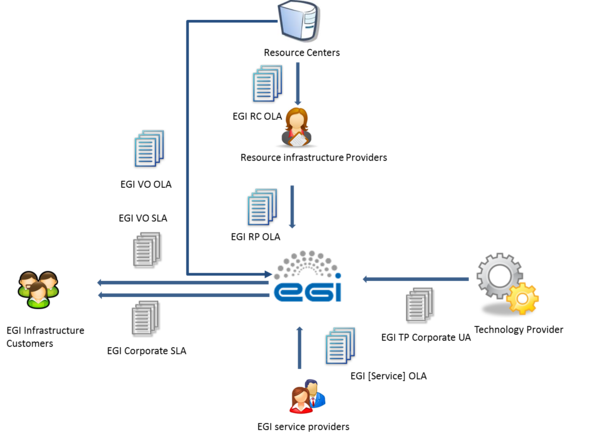EGI OLA SLA framework
| Main | EGI.eu operations services | Support | Documentation | Tools | Activities | Performance | Technology | Catch-all Services | Resource Allocation | Security |
| EGI OLA/SLA/UA framework: | EGI OLA SLA framework • | EGI OLA SLA status • | Metric Definitions • | RC performance • | RP performance • | EGI services performance • |
EGI Services have to comply with a minimum set of requirements to jointly offer a reliable, secure and highly available service infrastructure. These requirements are defined by the OLA/SLA framework, which supports service management at various levels: Resource Centre (RC), Resource infrastructure Provider (RP), EGI and Technology Provider.
The framework is comprised of agreements defining the minimum set of services and the corresponding minimum performance provided:
Service Level Agreemens
Service Level Agreement (SLA): An agreement between a Service Provider and a customer/client. The SLA describes the IT Service, documents service level targets and specifies the responsibilities of the Service Provider and the customer/client.. A single SLA may cover multiple IT Services or multiple customers/clients.
In EGI Framework there are following types of SLAs:
- EGI Corporate SLA - This agreement is valid for all services provided to support business processes according to the current valid Customer service catalogue, if no other agreements are in place. The Agreement may be extended or replaced by specific EGI VO SLAs
- EGI VO SLA - This agreement is a dedicated agreement for given Customer. The purpose is to create a reliable, trust-based communication channel between the Customer and the Providers to agree on the services, their levels and the types of support.SLAs are not legal contracts but, as agreements, they outline the clear intentions to collaborate and support research activities. EGI VO SLA is secured with related EGI VO OLAs and is agreed case by case.
Read more
Operational Level Agreements
Operational Level Agreement (OLA): An agreement between an IT Service Provider and another part of the same organisation. An OLA supports the IT Service Provider’s delivery of IT Services to Users. The OLA defines the goods or Services to be provided and the responsibilities of both parties.
In EGI Framework there are following types of OLAs:
- EGI Corporate OLA - This agreement is a generic EGI Operational Lever Agreement applicable to every single OLA.
- Resource Centre OLA- This document defines the minimum set of operational services and the respective quality parameters that a Resource Centre is required to provide in EGI.
- Resource infrastructure Provider OLA - This document defines the minimum set of operational services and the respective quality parameters that an EGI Resource infrastructure Provider is required to provide.
- EGI Services OLA - This agreements covers delivery of services required to operate EGI Infrastructure. Read More
- EGI VO OLA - The purpose of EGI VO OLA is to create a reliable, trust-based communication channel between the Customer and the providers to agree on the services, their levels and the types of support. The EGI VO OLAs are not legal contracts but, as agreements, they outline the clear intentions to collaborate and support research. EGI VO OLA supports delivery services promissed in given EGI VO SLA and is agreed case by case. Read more
Underpinning Agreements
Underpinning Agreement (UA): An agreement between an IT service provider and a third party. The third party provides goods or services that support delivery of an IT Service to a customer/client. The Underpinning Agreement defines targets and responsibilities that are required to meet agreed service level targets in one or more Service Level Agreements.
In EGI Framework there are following types of UAs:
- Corporate-level Technology Provider UA- This UA is generic Technology Provider Underpinning Agreements applicable to every single Technology Provider where no dedicated UA is agreed.
